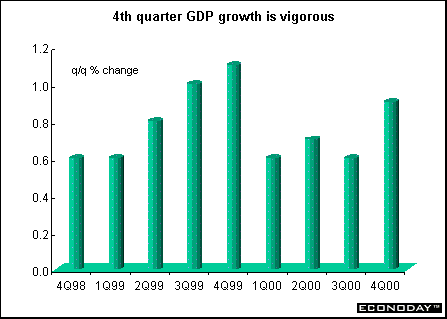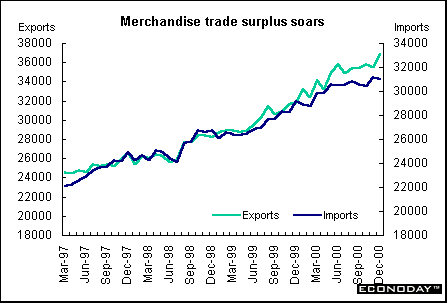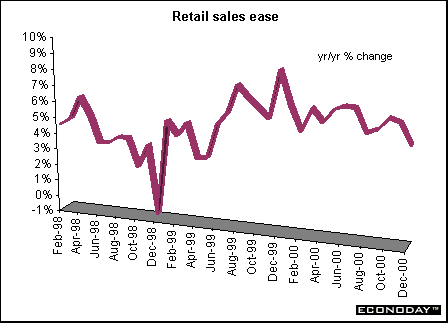
Indicator scoreboard
EMU - December merchandise trade surplus with the rest of the world was E700 million, less than a quarter of the surplus of E3.2 billion a year earlier. The decline was due to a stronger rise in imports (up 18 percent) than in exports (up 14 percent) when compared with last year. For the full year 2000, the trade surplus shrank to E12.6 billion because surging oil prices raised the value of energy imports.
December seasonally adjusted industrial production rose 2.0 percent and 8.0 percent when compared with last year. The strong monthly rise was due in large part to a 6.0 percent increase in the Netherlands - a result of strong consumer demand at the end of the year prior to the increase in the value added tax that took effect January 1. In the fourth quarter, production rose 1.1 percent on the quarter after rising 1.5 percent in the third quarter.

Germany - December real seasonally adjusted new construction orders rose 2.9 percent but dropped 3.3 percent when compared with a year ago. Building orders rose 3.3 percent in western Germany but were down 1.1 percent when compared with last year. East German construction orders increased 1.3 percent but dropped 10.7 percent when compared with last year.
December manufacturing orders were revised down to show a gain of 2.0 percent, well below the 2.7 percent gain originally reported. Overall fourth quarter orders were revised down marginally to a gain of 2.4 percent from 2.6 percent. West German orders were revised down to an increase of 1.6 percent from 2.1 percent originally reported. East German orders were revised down to an increase of 10.2 percent from 12.1 percent originally reported. The downward revision was confined to domestic orders, which were cut sharply to only a 0.4 percent gain from the 1.6 percent gain originally reported. Foreign orders, on the other hand, were revised up to 4.1 percent from 4.0 percent.

December pan-German industrial production was revised down to 0.2 percent from 0.7 percent. A regional breakdown shows that December industrial output was revised to 0.4 percent in west Germany from the 0.8 percent gain originally reported. East German output was revised down to a drop of 3.0 percent from the drop of 2.1 percent originally reported. Fourth quarter industrial production rose only 0.1 percent after revision. Details of the December data show that manufacturing output was revised down to up 0.3 percent from increase of 0.8 percent originally reported.

The January Ifo Institute's west German business sentiment index rose for the first time since May last year to 97.5 due exclusively to improved sentiment on current business conditions. Current conditions rose to 94.6 - the highest level since May last year - from 92.2 in December. The gain was likely related to the corporate and personal income tax cuts that took effect January 1. However, future expectations fell for the seventh time in the last eight months to their lowest level since May 1999.

Preliminary February consumer price index soared 0.6 percent and 2.6 percent when compared with last year. The annual harmonized CPI rate - the standard the ECB uses to gauge prices - jumped to 2.6 percent in February. Seasonally adjusted CPI jumped 0.5 percent and 2.6 percent when compared with last year.
January producer prices jumped 0.9 percent and 4.6 percent when compared with last year. The PPI excluding oil rose 1.0 percent and 4.5 percent on the year. Oil prices fell 3.6 percent on the month. A large part of the overall monthly increase was due to higher natural gas prices, which rose 8.9 percent, and electricity prices, which were up by 2.7 percent. Consumer goods jumped 0.6 percent on the month, with the annual rate rising to 2.5 percent from 1.9 percent.

France - December seasonally and workday adjusted manufacturing output rose 0.3 percent and 3.5 percent when compared with last year. Declines were concentrated in sectors most hit by the consumption slowdown linked to the mini-oil shock - autos, down 0.7 percent, and consumer goods, down 0.3 percent. However, these declines were outweighed by gains for semi-finished goods, up 0.7 percent, and capital goods, up 0.3 percent.
January seasonally and workday adjusted consumer spending on manufactured goods rebounded 3.2 percent and was up 5 percent when compared with last year. Household durable sales rose 6.2 percent while textile and leather goods sales surged 4.0 percent. Excluding autos, parts and pharmaceuticals, spending on manufacturing goods was up 3.3 percent on the month after a 0.1 percent decline in December but was up 5.3 percent when compared with last year.
Fourth quarter seasonally and workday adjusted gross domestic product rose 0.9 percent and 2.8 percent when compared with last year thanks to stronger exports and higher investment. For the year 2000, GDP rose a solid 3.2 percent. Quarterly growth in household spending slowed to 0.4 percent but investment growth jumped 2.4 percent with gains from business, households and government. Export growth accelerated sharply by 3.7 percent while import growth slowed to a 3.0 percent gain. Manufacturing output grew 1.3 percent while energy output fell 0.7 percent resulting in industry growth of 0.9 percent on the quarter.

January consumer prices dropped 0.4 percent as lower oil prices and seasonal retail discounts outweighed higher food, tobacco and services prices. When compared with last year, consumer prices rose 1.2 percent. Post Christmas shopping discounts, which began five days earlier this year, contributed strongly to the drop, cutting clothing prices by 4.9 percent on the month for a 0.9 percent decline in manufactured goods prices. Energy prices fell 4.8 percent on the month due mainly to a 7.6 percent drop in oil prices. Excluding energy, the CPI was flat on the month for an annual gain of 1.2 percent. Seasonally adjusted monthly core inflation rate, which excludes administered prices and volatile sectors such as food and energy, rose 0.4 percent but the annual core rate was steady at 1.4 percent.
Italy - January harmonized index of consumer prices rose 0.1 percent and 2.7 percent when compared with last year. The domestic index for all households (NIC) rose 0.4 percent on the month, up 3.0 percent when compared with last year. Differences in the health and leisure sectors were responsible for the substantial gap in the two indexes.
Spain - Fourth quarter real seasonally and workday adjusted gross domestic product rose 0.8 percent from the three months ended in September, after rising 0.9 percent from the second quarter. When compared with the year earlier, GDP jumped 3.8 percent. The economy grew 4.1 percent in all of 2000 after 4.0 percent in 1999, the fastest rate in two years. Spain has grown 4 percent or more in each of the past three years, well above the regional average.
Britain - February Confederation of Business Industries' monthly industrial trends survey showed total order books falling at a faster rate than in the previous month. Only 13 percent of manufacturers said orders were above normal while 37 percent said they were below, leaving a balance of -16 percent compared with -10 in January. Export orders were hardest hit. This balance fell to -24 percent in February from -14 percent in January despite sterling's recent weakening against the euro. Output expectations for the coming four months are also gloomier than in the previous two months. The output expectations balance fell to +9 percent from +14 percent in January. Price pressures are down sharply with the average prices balance falling to -14 percent from +4 percent in January.
Fourth quarter second estimate of gross domestic product remained at 0.3 percent increase and 2.5 percent when compared with last year as industrial output fell and the pace of activity in the service sector eased. Household expenditure slowed sharply in the fourth quarter, rising by 0.7 percent on the quarter and by 3.3 percent on the year. In contrast it rose by 1.0 percent in the third quarter. Service sector growth is still seen rising by 0.7 percent in comparison with growth of 1.1 percent in the third quarter. There was a sharp deceleration of growth within business services. Total production output fell by 0.6 percent on the quarter but was up 0.6 percent than a year earlier. Within this, manufacturing output rose by 0.5 percent on the quarter but the sector was dragged down by a sharp decline in the energy sector.

January merchandise trade deficit with countries outside the European Union narrowed to Stg2.458 billion from Stg2.767 billion in December. The trade deficit excluding oil and erratics was estimated at Stg2.0 billion compared with Stg2.1 billion in December. The value of exports to non-EU countries rose 1.8 percent while imports dropped 1.9 percent. The December whole world deficit widened to Stg2.806 billion from Stg2.363 billion in November. The trade deficit with European Union trading partners in December stood at Stg39 million versus Stg54 million in the previous month.
Asia
Japan - January merchandise trade posted a deficit of 95.28 billion yen ($824.3 million). This is the first time imports exceeded exports in four years. Exports rose 3.1 percent from a year earlier while imports surged 24 percent. The deficit was due largely to a deficit with other Asian countries, the first since January 1998. The trade surplus with the United States narrowed 3.9 percent to 457.4 billion yen, while the country posted a 184.8 billion yen deficit with the rest of Asia. In terms of quantity, exports fell 5.1 percent from a year earlier, while imports grew 12 percent. Exports to the United States slumped 12 percent in quantity terms, and have fallen five months in a row. The trade surplus with the European Union tumbled 36 percent to 140.4 billion yen in January, as exports were flat at 620 billion yen and imports grew 19 percent to 479.6 billion. Imports from the rest of Asia soared 29 percent, far outpacing a 5.6 percent climb in exports to the region. The Ministry said the growth in imports of products related to information technology and office equipment contributed to January's surge.
December all industry index rose 1.3 percent but was flat for the last quarter of 2000. The all industry index takes a reading of activity in the six industries that comprise the tertiary index combined with activity in the construction, agricultural and fisheries industries, the public sector and industrial output. The index is considered a close approximation for gross domestic product growth, as measured by industrial and service sector output.
December seasonally adjusted tertiary industry index rose 1.2 percent and 0.3 percent for the quarter. The tertiary index reflects activity in six industries - utilities, transport and telecommunications, wholesale and retail, finance and insurance, real estate and services. The gain was the eighth straight, though it was the smallest increase in a year. Service industries, which rely on domestic demand, are getting less business from manufacturers, which are scaling back production amid waning demand overseas.
Americas
Canada - December manufacturing shipments slipped 0.8 percent. Substantial decreases in the motor vehicle and aircraft and parts industries were partially offset by a significant increase in the electrical and electronic products industry. Shipments decreased in 13 of the 22 major groups, representing 60 percent of total shipments. For the year 2000, manufacturing shipments rose 9.2 percent, compared with gains of 9.3 percent in 1999 and 3.2 percent in 1998. Both unfilled orders and new orders decreased - unfilled orders by 0.6 percent and new orders by 1.2 percent, the third decline in four months.
December merchandise trade surplus rose to C$5.8 billion. Exports jumped 3.7 percent while imports declined 0.4 percent. Exports of energy products reached a record C$6.4 billion, up 40.7 percent from November. Exports of natural gas almost doubled from November (up 92.7 percent) in the wake of skyrocketing prices and strong demand in the United States. Heavy demand for Canadian electricity continued in California. Exports of electricity were up 16.2 percent. After two months of declines, crude petroleum exports rose 4.9 percent in December. Machinery and equipment exports were up 8.2 percent.

December seasonally adjusted retail sales jumped 0.9 percent and 5.1 percent when compared with last year. Food, up 2.5 percent and general merchandise retailers, up 2.4 percent contributed to the increase. For the year 2000 as a whole, retail sales jumped 6.3 percent.



Introduction • Global Stock Market Indexes • Recap of Global Markets • Currencies • Indicator Scoreboard

The Bottom Line • Looking Ahead
|